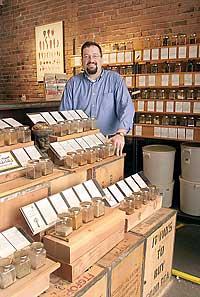Local merchant's first book details his search for international flavors

A modern Marco Polo, Hill describes his job in the spice trade as "a global treasure hunt." For most of the past decade, he's learned his craft at the source, traveling from China to India and Istanbul. He's been entranced by the flavor patterns that fingerprint a culture, bringing them to life for his customers. And now, the bits and pieces of his search have been bound together in his first book, "The Contemporary Encyclopedia of Herbs & Spices: Seasonings for a Global Kitchen" (Wylie, $40).
Hill, 38, an Arkansas native raised in Yakima, is a big guy who talks fast and knows his stuff. But he wasn't born into the business. In fact, his obsession took root quite by accident.
A college job working for IBM was followed by a short career selling computer systems to Navy contracts. He quickly burned out and in the early '90s began looking for a new direction.
A poker game provided the spark. One night, some betting buddies sat around his kitchen table, "deciding what I should do with my life," said Hill. On the nearby counter, 50 spice bottles were lined up in a ragged row. "You should be the 'Spice Boy' and make spice racks," was one pal's advice.
Mixing own blends
Though that suggestion was quickly discounted, he realized his interest lay in what went into those bottles, and a new career took seed. Using the Internet as a starting point for research, he quickly became hooked into the history and traditions of the global spice market. In 1995, he began a start-up business selling spices through the Internet and word of mouth.
World Spice Merchants, which opened a year later, is a no-frills operation run much like a country store. Framed by the shop's ruddy brick walls, plain wooden shelves hold clamp-topped jars filled with fragrant samples of spices and herbs.
Plastic tubs of various sizes are stacked on shelving behind a long wooden counter, where scoopfuls of seasonings are measured out, weighed and bagged. A flight of stairs leads down to a teahouse fitted with a comfy sofa and chairs.
Hill's warehouse is his garage, and he doesn't accept credit cards, even on the company's Web site. Customers fax in their orders, the goods are mailed and the customer sends back a check. As a retail practice, it's risky business. But, said Hill, "I've only gotten burned a couple of times."
The company mixes all its own dry blends such as tarragon-laced Provençal salt and Sri Lankan-style curries. Ideas flow from international tourists visiting the shop and from regular customers who bring in samples of blends discovered on recent travels, asking Hill to duplicate the flavors.
Hand-blended curry mixes are big sellers at World Spice, and he suggests buying the complex blends in their whole form and grinding them as needed. Hill describes hot as "a texture, a feeling in the mouth, not a flavor," so customers looking for a really hot curry powder are encouraged to add cayenne to taste.
And he recommends using the spices in long, slow cooking preparations, preferably in a crock pot, for developing the intensity of curries.
Globetrotting for spices
Tracking down sources for the best herbs and spices has often been a serendipitous event. "Invariably I get off the airplane and grab a cab," said Hill. "The driver has a cousin who has a friend that I might want to meet."
But recognizing quality comes only through experience. While it begins with the raw product, it's the skill in bringing that product to market at its peak that's the deal breaker.
For example, in Madagascar a lengthy process of drying vanilla beans over six months makes them the best in the world. But a number of factors, including a flood in 2000 that devastated the country's crops, have contributed to a diminished product the last few years.
Finding a replacement has been difficult. "While Mexico has a good bean, they rush it to market too quickly, and the quality is compromised," said Hill.
World events such as 9/11 have also changed the market landscape. Because Food and Drug Administration certification is now required for products brought into the United States, micro-growers who aren't able to afford the fees will be forced out of business, and the more unusual items may be eliminated. "While understandable," said Hill, "it's going to take awhile for regulations to sort out."
|
Australia is another up-and-coming source of interesting seasonings such as wild-crafted bush tomato and a potent mountain pepper with flavor similarities to the Sichuan peppercorn. (Sichuan peppercorns from Southeast Asia are currently banned by the United States Department of Agriculture because they may carry a canker that destroys citrus crops in California and Florida.)
High turnover of goods
Because Hill has the luxury of a small shop, catering to retail customers as well as chefs, he's able to buy small, high-end quantities that can be turned quickly.
Turnover of exotics such as cubeb pepper, long pepper and ahi chilies are limited to two to three months, while most other herbs and spices are turned over every three to four weeks. Hill would rather be without a product than have it sitting for long periods of time, diminishing its potency.
Working in a world of fragrant seasonings, Hill is reluctant to choose a favorite. "That's like asking who's your favorite child," he said, pausing before listing the must-haves in his cooking arsenal: juniper, rosemary, peppercorns, a good paprika and really fresh fennel seeds. His love of sage, passed along family lines, is legendary. Says Hill, "my recipes should come with a sage disclaimer."
CeCe Sullivan: csullivan@seattletimes.com


|